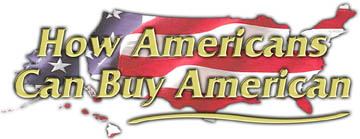 Supporting American-Made Products and Services from American-Owned Companies |
Ford and GM trade places for number one in U.S. auto production
Our Buy American Mention of the Week! by Roger Simmermaker March 6, 2015 For the first time since the 1930's, Ford has more U.S. hourly workers than General Motors, adding over 12,000 U.S. factory workers since 2011, equating to an increase of 10 union jobs per day. That's a glaring contrast to the way things were back in 2005, when Ford employed 21,000 fewer American jobs in domestic plants that Ford. That doesn't mean, however, GM has not been investing in American. General Motors has invested over $11 billion since bankruptcy proceedings in 2009, and is in the process of adding 750 more jobs at its Wentzville, Missouri plant, which is adding production of the re-designed GMC Canyon and Chevrolet Colorado. Ford has even added more American factory jobs despite having seven fewer auto plants compared to 2007, producing 125,000 more cars and trucks at the same time. Many maintain the popular refrain that GM was able to take advantage of government rescue funds that Ford never took, but it's important to know that Ford (as well as Nissan and Tesla) took government money as well. According to a Fox News report, Ford was handed $5.9 billion in taxpayer dollars in 2009, while Tesla and Nissan were given government loans of $2.1 billion each. Ford and GM, the only two American-owned auto companies left in the U.S. (I refer to them as the "Big Two"), have both expanded American jobs and American investment in America since the dark days of government loans and bailouts. Nissan, meanwhile, is now talking about how it wants to increase their U.S. market share to 10 percent by 2017, and is looking to expanding in Asia to do it. This would be a mere continuation of a pattern similar to production of the Nissan Rogue. The Rogue is built in Smyrna, Tennessee, but as sales increased, Nissan added production on places like Japan and South Korea to fill the demand, rather than expand production in existing American factories. Ford is also raising wages in the U.S., which is a key component to contributing to overall economic activity in America. Any economist will tell you that at least two-thirds of economic activity is based upon consumer spending. The more money people have in their pockets to spend, the higher the resulting economic activity. And, of course, more of that domestic spending stays within our national borders when we patronize American-made products built by American-owned companies like GM and Ford (more examples in other industries can be found at www.howtobuyamerican.com). Between 300 and 500 workers in Chicago will see their Ford-funded hourly wages increase from $19.28 to $28.50, and 55 other workers in Chicago, Louisville, and Kansas City have already seen a 50 percent increase in wages. Ford has been able to bolster U.S. exports to other countries resulting from its two-tier wage program with labor, and can now use that expansion of production and corporate profits to put upward pressure on U.S. wages again. In October of 2011, Ford signed a contract with the UAW in which it committed to "insourcing" 12,000 jobs to the United States from China, Japan, and Mexico over the course of the next four years. They have made good on that promise, and that's good for American jobs and American economic activity. And if the lid on gas prices in American holds to a reasonable degree, U.S. production increases in Ford's American factories should continue, especially with the popular F-150. Ford has already stated that it needs more American workers to support higher than expected demand for America's best-selling pickup truck. Although Ford does utilize Canada and Mexico for their North American production (as does GM and every other automaker on the planet) the United States comprised 78 percent of that production, compared to 61 percent for General Motors. But the larger point is, when you're in the market for a new car or truck, stick with the many American-made offerings from the "Big Two" American-owned companies, which are Ford and General Motors. That will help keep profits, jobs, and tax revenue within the borders of the USA. 1914
|
